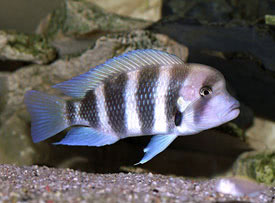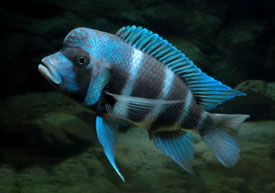
 Magyarul / Hungarian
Magyarul / Hungarian


- Scientific name: Cyphotilapia frontosa
- Common name: Frontosa
- Group: Cichlids
- Habitat: Africa; Lake Tanganyika
- Size: 30+ cm
- Biotope: Rocky waters with sandy bottoms starting at depths of approximately 30 feet.
- Social behavior: A peaceful, but territorial fish. The Frontosa is a semi-nocturnal feeder that stalks small, resting fish. Combine with other large pelagic (open water) Lake Tanganyika cichlids. One male should be kept with several females. Does best in schools.
- Diet: Feeds mostly on crustaceans and fish in nature. Will also accept insect larvae, aquatic insects, chopped meat, and fresh fish.
- Breeding: Quite easy.
- Tank: Minimum 370 litres
- Population: 1 male and 2 females for 500 litres
- Decoration: Use a coral sand substrate and create caves and crevices with large rock structures. Plants can be used.
- Temperature: 25-26°C
- pH: 7,4-8
- Hardness: 12-15 NK°
- Lifespan: 15-25 years
Description: A beautiful fish, the base color is a bright white. The body is crossed with five or six broad black bands. The fins are a translucent blue to aqua and contrast with the rest of the body. There are variations on the number of bands and fin color depending on the morph and even the individual.
Like all true Tanganyikan set ups the tank should be decorated with a crushed coral or similar substrate and contain lot of rocks that form caves and crevices. The rocks must be firmly anchored as these fish will dig a lot and can disrupt the aquascape and possibly hurt themselves or the aquarium. Plants can be used and will not be eaten but should be placed carefully as their digging will continually uproot them. Peaceful for a cichlid they should be kept in groups of one male to three or four females. Feeding is not a problem as they will accept all types of flake and frozen food, in nature they are twilight ambush hunters that lie in wait for smaller fish so the addition of high protein food, such as fish, meat, shrimp, and beef heart is always beneficial. Good filtration is a must and frequent partial water changes are a necessity as well.
A mouthbrooder the Frontosa is a little more selective than most and the ratio of three to one is needed to form a proper pair. The next step is the selection of the spawning site. A smooth rock lying on the bottom or even a bit of rockwork showing through the sand will be chosen and the pair will begin to clear away as much sand as possible from the area and excavate a spawning pit or shelf upon which to place their spawn. The female will place a few eggs in the pit and the male will follow and fertilize them. This will continue until the female picks up the eggs in her mouth and starts the incubation period. The mother will incubate the eggs for about a month and then the young will emerge. They are fairly large in size (about .5")and can be fed newly hatched frozen or live brine shrimp. The mother will guard the fry for a period.



